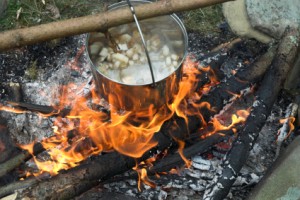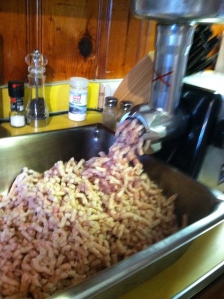 Rendering the fat of animals (beef, sheep, bear, deer, and poultry) is a process that produces tallow.
Rendering the fat of animals (beef, sheep, bear, deer, and poultry) is a process that produces tallow.
Lard is pig fat that has been rendered. Since I don’t have a source of pastured pig fat, I use grass-fed beef fat. My butcher at our local Earth Fare market freezes grass-fed beef fat just for me. Just picked up 8 more pounds yesterday. I’m now known as the ‘fat man’ every time I walk by their meat counter.
Finding Healthy Fat
Don’t expect to find grass-fed beef fat at big chain supermarkets. I’ve not had success dealing with the big boys. If you don’t have a store that sells grass-fed animals, local farmers may be an option. Of course, the animals need to be raised naturally – not factory farmed.
Here’s a couple of resources that will ship omega 3 and CLA-rich grass-fed tallow to your door!
- US Wellness Beef
- Grass Fed Traditions
- Eat Wild
- Eat Local Grown
- Local farmer’s markets, food coops, and locally grown farmers/ranchers
Why grass-fed, free-range, and naturally raised? Factory farmed animals are pumped with hormones, fed chemicals, and are just not happy animals. Just ask them. If you use tallow for cooking or skin care, you want the best quality fat you can find.
If the thought of eating tallow is disgusting to your delicate sensitivities or eating style, consider the many other uses for animal fat.
12 Non-Cooking Uses for Tallow
1. Cooking is the most obvious use at our home. Tallow has a high smoke point (420 degrees) making it an excellent oil for frying foods. This means you can fry on higher heats without creating free radicals in the oil which is a concern with vegetable oils.
2. Skin care – Saturated animal fat (tallow) was used for beauty products back before the low-fat myth became ‘truth.’ Your grandma and grandpa likely used it to heal cracked, dry hands and as a moisturizer.
Tallow is biologically compatible with our bodies largest organ, our skin. Animal fat contains vitamins A, D, K, and E.
Tallow (especially tallow from grass-fed animals) also contains fats like conjugated linoleic acid (CLA), which has anti-cancer and anti-inflammatory properties, as well as palmitoleic acid, which has natural antimicrobial properties. – Source
3. Lubricate stuff, like the proverbial squeaky wheel. Tallow greases moving parts but is resistant to water. Steam engines and ships uses tallow for many years to keep things running smoothly.
4. Flux for soldering.
5. Leather conditioner.
6. Soap making. The best shaving bars are made from tallow.
7. Candle making. Can’t make a traditional candle? Improvise by placing tallow in a container with a piece of cotton clothe in emergencies.
8. Biodegradable motor oil.
9. Deer tallow is preferred by German athletes to make a salve to prevent sore skin and blisters.
10. Biodiesel. Tallow can be used like plant-based material to produce diesel.
11. Make your own pemmican.
12. Pastry baking.
13. Lubricate muskets and rifles.
The DiY Rendering Process
Step 1: Trim the grass-fed beef (or other animal fat). You want to get all the red meat off the fat.
Step 2: Cut into small squares. The smaller the cuts, the more surface area is exposed. I did this cutting twice. Then, in a stroke of SmartPrepper brilliance, I pulled out my meat grinder. Now I just stuff the trimmed fat into the meat grinder and collect it my cast iron pan.
Way faster and creates more surface area!
Step 3: Load your cut or ground fat into a pan or cooking container. I use a large cast iron skillet. Be careful not to overload the pan with fat. It will cook down. But you don’t want to have to transfer hot tallow if it’s up to the lip of your container.
Step 4: Heat your pan of fat on low heat. I shoot for 200-250 degrees. I set up in my outdoor kitchen. My turkey fryer is my heat source. You can use your stove if you don’t mind smelling up your house a bit. It ain’t as bad as cooking chitlins. Still, a distinctive odor.
Almost ready.
As I’m typing this, I’m thinking I could use my Big Green Egg on my next batch. It’s so easy to control the temp – set it, and forget it!
Step 5: Stir the fat occasionally just make sure it doesn’t sick to the bottom of your pan. You’ll notice liquid starting to collect in the pan. If it begins to smoke, you’re burning fat and not rendering it. Turn down the heat.
Step 6: Once you notice the fat turning a dark brown (think crispy bacon), you’re done. Take the pan off the heat and let it cool for a while. If it cools to room temp, you’ll have to reheat to liquify for pouring.
Step 7: Once it’s cooled down a bit, pour the contents through a fine mesh strainer. You can add cheese cloth to the strainer to catch even smaller pieces. I’ve stored tallow in wide mouth mason jars. We go through tallow pretty quickly around here. Mostly, we just pour it up in a few two quart containers and place them in the fridge. Tallow can be stored in the freezer as well.
Oxidation can cause the tallow to go rancid. From what I’ve read and followed myself, rendering the water out of the tallow prevents the oxidation to occur. To be on the safe side, we store ours in the fridge.
I’ve read of other methods of rendering tallow by using a slow cookers. Never tried it.
Any of you rendered tallow or lard in a different way? I’m always interested in learning new ways. Drop your method in the comments if you’d like.
Keep doing the stuff,
Todd
This article was originally published at Ready Nutrition™ on August 21st, 2013









I just rendered the fat from our sheep, some on our wood stove with some water in the bottom and the rest in my slow cooker. Both worked well. I’ve just turned 1.3kg of sheep tallow into soap which I will cut tonight. The smell is distinctive but with the lid on it wasn’t too bad.
Thanks for the great information! I make bone broth (via my slow cooker) and always get a few tablespoons on tallow by doing that. It’s a small amount, but something is better than nothing!
I just rendered my own for the first time – I used a roaster. I rendered it for three days – and haven’t used it yet but hope it came out ok!